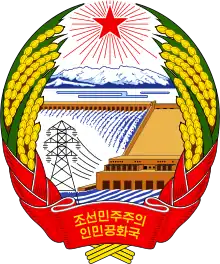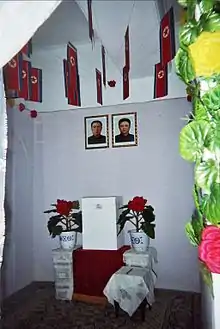Elections in North Korea
Elections in North Korea are held every four-to-five years for the Supreme People's Assembly (SPA), the country's national legislature, and every four years for Local People's Assemblies.[1][2]
 |
|---|
|
|
.jpg.webp)

All seats are won by the Democratic Front for the Reunification of Korea.[3] The founding and ruling Workers' Party of Korea dominates the Front and holds 87.5% of the seats, with 7.4% for the Korean Social Democratic Party, 3.2% for the Chondoist Chongu Party, and 1.9% for independent deputies.[4] According to official reports, turnout is near 100%, and approval of the Democratic Front's candidates is unanimous or nearly so.[1] North Korean elections have been criticized by many as being sham elections,[5] though officially the DPRK denies this.
Procedure
In reply to a question put forth by Michael Marshall, Li Chun Sik of North Korea stated at a meeting of the Association of Secretaries General of Parliaments (ASGP) of the Inter-Parliamentary Union:[6]
While candidates could be nominated by anyone, it was the practice for all candidates to be nominated by the parties. These nominations were examined by the United Reunification Front and then by the Central Electoral Committee, which allocated candidates to seats. The candidate in each seat was then considered by the electors in meetings at the workplace or similar, and on election day the electors could then indicate approval or disapproval of the candidate on the ballot paper.
Only one candidate appears on each ballot.[7][8] Elections are ostensibly conducted by secret ballot, and a voter may cross off the candidate's name to vote against them. Voting is mandatory and turnout is habitually near 100%.[9]
Members of the Supreme People's Assembly are elected to five-year terms, and meet for SPA sessions up to ten days per year.[10] The Supreme People's Assembly elects a standing committee known as the Standing Committee, which exercises legislative functions when the Assembly is not in session which in practice is all but a few days of the year. It also elects the President of the State Affairs Commission, the country's head of state and highest state office, and the premier, the country's de jure head of government.[11]
Local elections
Local elections have been held since 1999.[12] The people elect representatives to city, county, and provincial people's assemblies in local elections every four years.[1] The number of representatives is determined by the population of each jurisdiction.[13]
Regarding this, scholar Andrei Lankov of Kookmin University in Seoul stated that "They have a dual system: there is a mayor/governor, technically elected (but actually appointed), and also there is a city/province party secretary. It is the latter who has real power, but mayor/governor can be important in some cases as long as he knows his proper place and does not challenge the Workers' Party of Korea secretary."[14]
Criticism
The elections have been variously described as show elections or a political census.[15][16] Seats are uncompetitive as all candidates are chosen by the Democratic Front for the Reunification of Korea.[3][6][8] Because of the near 100% turnout, elections double as unofficial censuses. The inminban neighborhood watch-style organization reportedly watches the elections to identify and investigate no-shows.[9]
South Korean news reporter, Dae Young-kim, claims that there are separate boxes for "no" votes.[17] According to him, voting against the official candidate, or refusing to vote at all, is considered an act of treason, and those who do face the loss of their jobs and housing, along with extra surveillance.[17]
Latest election
The latest election was held on 10 March 2019.[18]
| Alliance | Party | Votes | % | Seats |
|---|---|---|---|---|
| Democratic Front for the Reunification of Korea |
General Association of Korean Residents in Japan | 5 | ||
| Others | 682 | |||
| Total | 100 | 687 | ||
| Registered voters/turnout | 99.99 | – | ||
| Source:[19][18] | ||||
Past elections
By-elections
References
- "DPRK Holds Election of Local and National Assemblies". People's Korea. Archived from the original on 10 May 2012. Retrieved 28 June 2008.
- "The Parliamentary System of the Democratic People's Republic of Korea" (PDF). Constitutional and Parliamentary Information. Association of Secretaries General of Parliaments (ASGP) of the Inter-Parliamentary Union. p. 4. Retrieved 1 October 2010.
- Moon, Angela; Sugita Katyal; Ralph Boulton (8 March 2009). "N.Korea vote may point to Kim successor". Reuters. Retrieved 8 March 2009.
- "The Parliamentary System of the Democratic People's Republic of Korea" (PDF). Constitutional and Parliamentary Information. Association of Secretaries General of Parliaments (ASGP) of the Inter-Parliamentary Union. p. 5. Archived from the original (PDF) on 3 March 2012. Retrieved 1 October 2010.
- "North Korea election turnout 99.99 percent: State media". www.aljazeera.com. Retrieved 31 May 2021.
- "The Parliamentary System of the Democratic People's Republic of Korea" (PDF). Constitutional and Parliamentary Information. Association of Secretaries General of Parliaments (ASGP) of the Inter-Parliamentary Union. pp. 17–18. Retrieved 1 October 2010.
- "North Korea votes for new rubber-stamp parliament". Associated Press. 8 March 2009.
- "Kim wins re-election with 99.9% of the vote". The New York Times. 9 March 2009.
- Emily Rauhala (10 March 2014). "Inside North Korea's sham election". Time. Retrieved 24 April 2015.
- "The Parliamentary System of the Democratic People's Republic of Korea" (PDF). Constitutional and Parliamentary Information. Association of Secretaries General of Parliaments (ASGP) of the Inter-Parliamentary Union. Retrieved 1 October 2010.
- The Far East and Australasia 2003 (34th ed.). London: Europa Publications. 2002. p. 680. ISBN 978-1-85743-133-9.
- "North Korea elections: What is decided and how?". BBC News. 19 July 2015. Retrieved 26 November 2015.
- Kim Seong Hwan (10 June 2015). "NK to hold local elections next month". DailyNK. Retrieved 11 June 2015.
- York, Rob (9 June 2015). "North Korea's local elections coming in July". NK News. Retrieved 11 June 2015.
- Choe Sang-Hun (9 March 2014). "North Korea Uses Election To Reshape Parliament". The New York Times. Retrieved 18 March 2014.
- Hotham, Oliver (3 March 2014). "The weird, weird world of North Korean elections". NK News. Retrieved 17 July 2015.
- Alma Milisic (19 July 2015). "Foregone result in North Korea's local elections". Al-Jazeera English.
- Zwirko, Colin (12 March 2019). "Kim Jong Un left off list of officials elected to 14th Supreme People's Assembly". NK News. Retrieved 18 March 2019.
- 최고인민회의 대의원으로 선출된 재일동포들. Choson Sinbo (in Korean). 15 March 2019. Retrieved 17 March 2019.